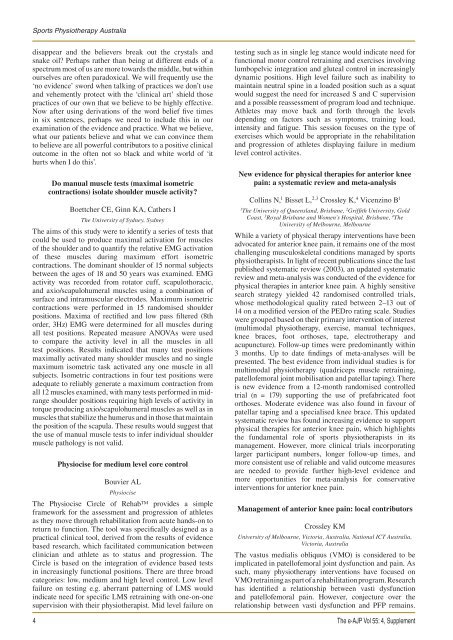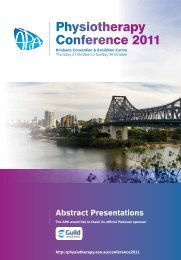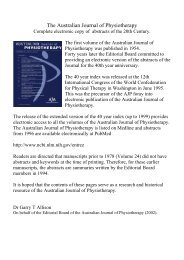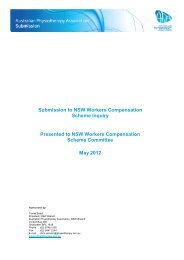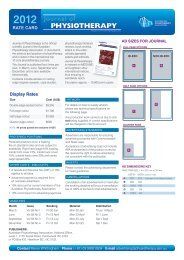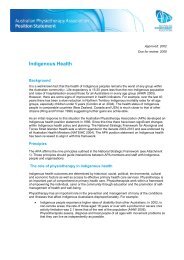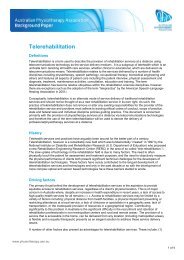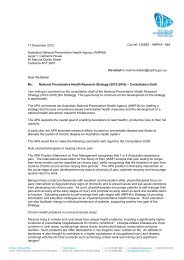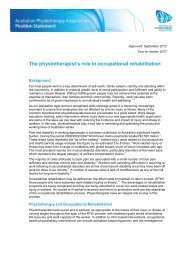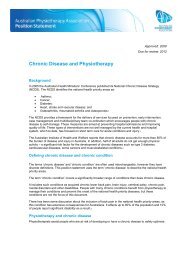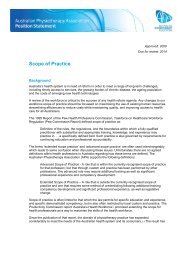2009 APA Conference Week Abstracts - Australian Physiotherapy ...
2009 APA Conference Week Abstracts - Australian Physiotherapy ...
2009 APA Conference Week Abstracts - Australian Physiotherapy ...
You also want an ePaper? Increase the reach of your titles
YUMPU automatically turns print PDFs into web optimized ePapers that Google loves.
Sports <strong>Physiotherapy</strong> Australia<br />
disappear and the believers break out the crystals and<br />
snake oil? Perhaps rather than being at different ends of a<br />
spectrum most of us are more towards the middle, but within<br />
ourselves are often paradoxical. We will frequently use the<br />
‘no evidence’ sword when talking of practices we don’t use<br />
and vehemently protect with the ‘clinical art’ shield those<br />
practices of our own that we believe to be highly effective.<br />
Now after using derivations of the word belief five times<br />
in six sentences, perhaps we need to include this in our<br />
examination of the evidence and practice. What we believe,<br />
what our patients believe and what we can convince them<br />
to believe are all powerful contributors to a positive clinical<br />
outcome in the often not so black and white world of ‘it<br />
hurts when I do this’.<br />
4<br />
Do manual muscle tests (maximal isometric<br />
contractions) isolate shoulder muscle activity?<br />
Boettcher CE, Ginn KA, Cathers I<br />
The University of Sydney, Sydney<br />
The aims of this study were to identify a series of tests that<br />
could be used to produce maximal activation for muscles<br />
of the shoulder and to quantify the relative EMG activation<br />
of these muscles during maximum effort isometric<br />
contractions. The dominant shoulder of 15 normal subjects<br />
between the ages of 18 and 50 years was examined. EMG<br />
activity was recorded from rotator cuff, scapulothoracic,<br />
and axio/scapulohumeral muscles using a combination of<br />
surface and intramuscular electrodes. Maximum isometric<br />
contractions were performed in 15 randomised shoulder<br />
positions. Maxima of rectified and low pass filtered (8th<br />
order, 3Hz) EMG were determined for all muscles during<br />
all test positions. Repeated measure ANOVAs were used<br />
to compare the activity level in all the muscles in all<br />
test positions. Results indicated that many test positions<br />
maximally activated many shoulder muscles and no single<br />
maximum isometric task activated any one muscle in all<br />
subjects. Isometric contractions in four test positions were<br />
adequate to reliably generate a maximum contraction from<br />
all 12 muscles examined, with many tests performed in midrange<br />
shoulder positions requiring high levels of activity in<br />
torque producing axio/scapulohumeral muscles as well as in<br />
muscles that stabilize the humerus and in those that maintain<br />
the position of the scapula. These results would suggest that<br />
the use of manual muscle tests to infer individual shoulder<br />
muscle pathology is not valid.<br />
Physiocise for medium level core control<br />
Bouvier AL<br />
Physiocise<br />
The Physiocise Circle of Rehab provides a simple<br />
framework for the assessment and progression of athletes<br />
as they move through rehabilitation from acute hands-on to<br />
return to function. The tool was specifically designed as a<br />
practical clinical tool, derived from the results of evidence<br />
based research, which facilitated communication between<br />
clinician and athlete as to status and progression. The<br />
Circle is based on the integration of evidence based tests<br />
in increasingly functional positions. There are three broad<br />
categories: low, medium and high level control. Low level<br />
failure on testing e.g. aberrant patterning of LMS would<br />
indicate need for specific LMS retraining with one-on-one<br />
supervision with their physiotherapist. Mid level failure on<br />
testing such as in single leg stance would indicate need for<br />
functional motor control retraining and exercises involving<br />
lumbopelvic integration and gluteal control in increasingly<br />
dynamic positions. High level failure such as inability to<br />
maintain neutral spine in a loaded position such as a squat<br />
would suggest the need for increased S and C supervision<br />
and a possible reassessment of program load and technique.<br />
Athletes may move back and forth through the levels<br />
depending on factors such as symptoms, training load,<br />
intensity and fatigue. This session focuses on the type of<br />
exercises which would be appropriate in the rehabilitation<br />
and progression of athletes displaying failure in medium<br />
level control activites.<br />
New evidence for physical therapies for anterior knee<br />
pain: a systematic review and meta-analysis<br />
Collins N, 1 Bisset L, 2,3 Crossley K, 4 Vicenzino B 1<br />
1<br />
The University of Queensland, Brisbane, 2 Griffith University, Gold<br />
Coast, 3 Royal Brisbane and Women’s Hospital, Brisbane, 4 The<br />
University of Melbourne, Melbourne<br />
While a variety of physical therapy interventions have been<br />
advocated for anterior knee pain, it remains one of the most<br />
challenging musculoskeletal conditions managed by sports<br />
physiotherapists. In light of recent publications since the last<br />
published systematic review (2003), an updated systematic<br />
review and meta-analysis was conducted of the evidence for<br />
physical therapies in anterior knee pain. A highly sensitive<br />
search strategy yielded 42 randomised controlled trials,<br />
whose methodological quality rated between 2–13 out of<br />
14 on a modified version of the PEDro rating scale. Studies<br />
were grouped based on their primary intervention of interest<br />
(multimodal physiotherapy, exercise, manual techniques,<br />
knee braces, foot orthoses, tape, electrotherapy and<br />
acupuncture). Follow-up times were predominantly within<br />
3 months. Up to date findings of meta-analyses will be<br />
presented. The best evidence from individual studies is for<br />
multimodal physiotherapy (quadriceps muscle retraining,<br />
patellofemoral joint mobilisation and patellar taping). There<br />
is new evidence from a 12-month randomised controlled<br />
trial (n = 179) supporting the use of prefabricated foot<br />
orthoses. Moderate evidence was also found in favour of<br />
patellar taping and a specialised knee brace. This updated<br />
systematic review has found increasing evidence to support<br />
physical therapies for anterior knee pain, which highlights<br />
the fundamental role of sports physiotherapists in its<br />
management. However, more clinical trials incorporating<br />
larger participant numbers, longer follow-up times, and<br />
more consistent use of reliable and valid outcome measures<br />
are needed to provide further high-level evidence and<br />
more opportunities for meta-analysis for conservative<br />
interventions for anterior knee pain.<br />
Management of anterior knee pain: local contributors<br />
Crossley KM<br />
University of Melbourne, Victoria, Australia, National ICT Australia,<br />
Victoria, Australia<br />
The vastus medialis obliquus (VMO) is considered to be<br />
implicated in patellofemoral joint dysfunction and pain. As<br />
such, many physiotherapy interventions have focused on<br />
VMO retraining as part of a rehabilitation program. Research<br />
has identified a relationship between vasti dysfunction<br />
and patellofemoral pain. However, conjecture over the<br />
relationship between vasti dysfunction and PFP remains.<br />
The e-AJP Vol 55: 4, Supplement


